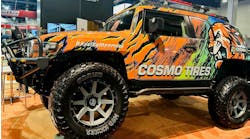There are plenty of reasons for tire makers to be optimistic about the CUV and SUV tire markets in the United States.
A declining unemployment rate and a rebound in housing have created good economic conditions, and consumers are spending money on vehicles. They’re also driving more, and a growing number of the vehicles they choose to drive are CUVs.
According to R.L. Polk & Co., nearly one million more new CUVs were purchased in the U.S. in 2012 than in 2008 at the height of the economic downturn. Consumers purchased 2.28 million new CUVs in 2008 and 3.24 million in 2012. During that time, SUV sales did not fare as well. In 2008 there were 1.27 million new SUVs sold to U.S. consumers; in 2012 it was 1.18 million, a decrease of more than 88,000.
While the CUV segment continues to grow, the SUV segment is still holding ground.
“The SUV/LT segment, in both vehicles and tires, reached a recent high mark in 2007, but then dipped sharply from 2008 to 2010 before beginning a steady upward growth trend in recent years,” says a spokesperson for Goodyear Tire & Rubber Co. “This is attributable to the functionality of these vehicles, easing credit that helped the vehicle sales gains, and more stable fuel prices.”
Consumers are holding onto their cars for longer periods of time. Polk says the average age of CUV and SUV vehicles (segments combined) on the road is 8.98 years as of Jan. 1, 2013, up 1.66 years from 7.32 years in 2008. This shift is creating replacement tire opportunities for tire makers and dealers.
[PAGEBREAK]
SUVs are hanging in there
There are still more SUVs on the road than CUVs.
“The SUV replacement tire market is showing signs of an uptick and should see 2% growth over the next three years,” says Michael Burns, marketing manager at Del-Nat Tire Corp.
According to Polk, as of July 2013, the total number of CUVs on U.S. roadways was 26.9 million, making up 11.1% of vehicles in operation (VIO). But plenty of SUVs are still being driven, as they make up 13.4% of VIO at 32.6 million.
Polk classifies CUVs and SUVs under the light truck umbrella. The Rubber Manufacturers Association (RMA) classifies them differently as far as tires are concerned.
“We put CUV and SUV tires in the passenger tire category,” says Dan Zielinski, RMA’s senior vice president of public affairs. “Our members may separately segregate them according to size and put some as CUV and others as SUV.”
Zielinski says the RMA does not separate CUVs and SUVs from the passenger tire category because RMA members may classify them somewhat differently for their own purposes.
According to the RMA, the CUV and SUV replacement tire market is coming out of the slump the industry was seeing from 2010 to 2012, when RMA member passenger tire units fell from 49.5 million units to 47.5 million.
The market is anticipated to come back to 48.6 million units in 2013, with a three-year compound annual growth rate at 2.2%. Sport utility and crossover vehicles still claim approximately one-third of the spots on the top vehicle sales rankings, a statistic that’s been holding steady for some time now. RMA members are not expecting any big changes in the near future.
Like Polk, Modern Tire Dealer classifies CUVs and SUVs in the light truck category, but like the RMA, these vehicles’ tires are considered to be in the passenger tire category. According to the 2013 MTD Facts Issue, replacement tire sales for passenger tires remained relatively flat the last two years, totaling $24.7 billion in 2012 and $25 billion in 2011. The total number of passenger replacement units shipped in the U.S. has dipped slightly in the last five years, from a total of 195 million in 2008 to 192.7 million in 2012.
OE units shipped have come back steadily since the recession, when total units dropped from 39 million in 2008 to 25 million in 2009, recovering to a total of 40.7 million units in 2012. As the OEMs keep up with consumer demand for more CUV models every year, tire makers keep up with the trend.
“I think a lot of tire manufacturers are starting to build products just for the CUV market,” says John Aben, senior vice president of sales and marketing at Nexen Tire America Inc. “CUVs are similar to SUVs, but there are a lot of sizes that the SUV tread patterns wouldn’t necessarily fit. Some of the manufacturers, including Nexen, are looking to expand their pattern designs for CUVs.”
Aben says because the tread patterns on SUV tires make more noise, they aren’t well-suited to the typical CUV driver.
“CUVs are smaller than SUVs, but the people driving them don’t want to hear noise,” says Aben. “They’re more into comfort.”
[PAGEBREAK]
Rim diameters keep growing
While consumer demand for comfort and utility increases, rim diameters are increasing as well.
“A major trend we have identified in both CUVs and SUVs is the preference for larger rim diameter fitments,” says Justin Hayes, product manager, Bridgestone Americas Tire Operations LLC, U.S. & Canada Consumer Tire Sales Division. “When SUVs came to prominence in the late 1980s and early 1990s, the market was dominated by 15- and 16-inch fitments. The same was true for CUVs as they emerged in the early 2000s.”
Hayes says now we are seeing a rapid shift toward 18-, 19- and 20-inch fitments, with even some 22-inch tires on more premium vehicles.
“Mainstream CUVs like the new Ford Escape and Chevrolet Equinox have 19-inch options, and luxury CUVs like the Infiniti FX and the Lincoln MKX have 21- and 22-inch options, respectively,” says Robert Abram, product planning manager at Yokohama Tire Corp.
The rapid shift to larger rim diameters by OEMs has led to H-, V- and T-rated tires with shorter sidewalls, according to Stephen Peters, light truck specialist at Michelin North America Inc. The overall diameter has not increased significantly.
“For example, 20-inch and larger sizes, which were once leaning more to niche applications, have become vastly more mainstream,” says Peters. “With GM moving to 22-inch wheels on SUVs such as the Cadillac Escalade and GMC Yukon, consumer impressions on accessibility of these tires has also changed. Many dimensions previously associated with large passenger cars are now found on smaller CUVs.”
OEMs lead the charge
“OEMs are releasing more crossover variants, so the tire industry has responded with sizes and patterns to cover these new vehicles,” says John Wu, assistant product manager for Maxxis International. “It is definitely a growing market segment, and Maxxis will be watching it closely.”
As tire makers keep up with increasing demands at the OEM level, they are also challenged to anticipate future trends.
“For the OE market, we see increased emphasis on performance and reduced rolling resistance, reduced wet and dry stopping distances, improved snow traction and reduced noise levels,” says Steve Carpino, vice president of research and development, Pirelli Tire North America Inc. “We expect to see requests for improved tread wear.”
In the replacement market, the trends are reducing wet and dry stopping distances and reducing noise levels, according to Carpino, in addition to increasing tread wear.
“We will likely see an increased emphasis on rolling resistance as labeling regulations are implemented in the U.S.”
Fuel efficiency drives demand for low rolling resistance tires. It has also fueled the trend toward lighter-weight vehicles.
“The CUV and SUV market is evolving from vehicles with a truck-based body-on-frame chassis, to a car-based unibody chassis,” says Joe Maher, product manager, passenger and winter tires for Continental Tire the Americas LLC.
“Vehicles are trending smaller into more of a station wagon-type vehicle, and vehicle owners expect a car-like ride and handling.
“Large SUVs historically have been truck-based, but many are moving to car-based construction with an (auto) body style that communicates ‘truck.’”
[PAGEBREAK]
What lies down the road?
What do the shifting CUV/SUV markets mean for tire dealers?
“The CUV market is a rapidly growing and changing segment as these newer vehicles age into their first and second tire replacement cycles,” says Bridgestone’s Hayes. “SUVs have been around for a little longer, and their sales volumes have not yet regained the peak levels seen in the early 2000s.”
“The CUV market continues to grow at the expense of the larger SUV models and traditional passenger vehicles,” says Scott Jamieson, director of product management at Cooper Tire & Rubber Co. Jamieson says the CUV is the new family vehicle and will continue to have higher speed ratings and larger rim diameters than SUVs and passenger vehicles.
“To the consumer this is their ‘car’ or their ‘truck,’” says David Shelton, marketing director for GITI Tire (USA) Ltd. “The distinction of CUV or SUV means very little to them. When the consumer describes his vehicle as a car or a truck they are giving clues to the dealer regarding the tire characteristics they expect. CUV owners desire more car-like characteristics.”
The CUV segment will continue to grow as consumers require more space and utility and move toward more efficient vehicles, according to Maxwell Wee, director of sales, Sentaida International Inc. But he also remains optimistic about SUVs.
“The SUV segment is also rebounding as vehicle manufacturers start to roll out car-based SUVs to improve efficiency.”
“CUV is still a growing market as more vehicle manufacturing is moving toward a unibody structure for fuel efficiency and cost advantages,” says Fardad Niknam, senior director of product planning and technical services for Toyo Tire U.S.A. Corp. “The SUV market took a downturn during the recession, but is now coming back to the level it was before the financial meltdown.”
“Similar to the touring tire market, fuel efficiency, wear and comfort have become more important characteristics for CUV and SUV tires in the market,” says Eric Yang, automotive marketing manager at Kenda U.S.A., a division of American Kenda Rubber Industrial Co. Ltd. “New constructions and compounds have allowed tire makers to improve all these characteristics dramatically.”
“As consumers trend further and further toward fuel efficiency, I expect growth in CUV fitments to become much stronger,” says Del-Nat’s Burns. “Competition for share of the dealer’s screen will be significant. CUV drivers want a high-quality tire at a low cost.”
Goodyear says retailers will need to continue to focus on the needs of CUV and SUV drivers, including daily driving as part of an active lifestyle and off-roading on the weekends. These consumers depend on their SUVs and CUVs and they keep them well-maintained so their vehicle is always ready for multi-use.
“Most auto manufacturers have developed hybrid CUVs and SUVs like the Ford Escape and Toyota Highlander,” says Bridgestone’s Hayes. “For these vehicles, the preferred tire not only has a larger rim diameter, but also has a low rolling resistance, which helps vehicles achieve better overall fuel efficiency. These are the types of emerging demands that are expected from products in this segment.” ■
CUV or SUV? Unibody vs. body-on-frame construction
According to Tom Libby, senior forecasting analyst with R.L. Polk & Co., the general rule for differentiating between the CUV and SUV segments is if the vehicle is car-based, if it’s on a unibody construction, then it’s categorized as a crossover. If it’s a truck body-on-frame architecture, then it’s categorized as an SUV.
An example of a CUV is the Ford Escape (unibody construction), whereas the Ford Expedition (body-on-frame construction) is classified as an SUV.
Under the light truck category, which Libby says is an umbrella category, Polk includes pickups, CUVs, SUVs and vans.
“CUVs are doing very well. The non-luxury compact CUV segment is thriving and that includes the Ford Escape, the Toyota RAV4, the Honda CR-V and the Chevrolet Equinox. That segment is a real sweet spot in the market and it’s growing hugely.”
While SUVs still make up 13.4% of vehicles in operation, Libby says this segment is declining.
“The non-luxury compact SUV segment is dwindling. That includes the Jeep Wrangler and the Nissan Xterra.”
Libby says there are not a lot of other vehicles in the SUV category because of the success of CUVs.
“To compete with the RAV4, the Escape and the Equinox, manufacturers are developing more car-based vehicles. The truck-based group is losing out.”



